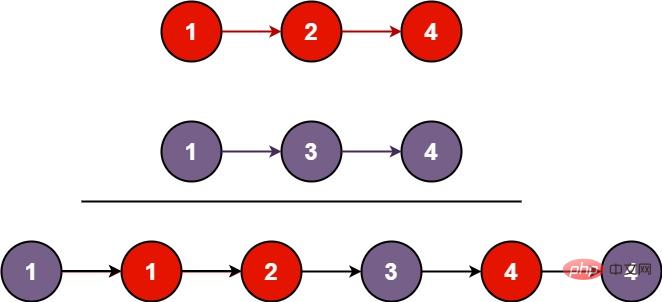
将两个升序链表合并为一个新的升序链表并返回。新链表是通过拼接给定的两个链表的所有节点组成的。
示例 1:

输入:l1 = [1,2,4], l2 = [1,3,4]
输出:[1,1,2,3,4,4]
示例二:
输入:l1 = [], l2 = []
输出:[]
示例 3:
输入:l1 = [], l2 = [0]
输出:[0]
新建一个空的链表 nList
在两个链表(l1,l2)都不为空的情况下,比较两个链表的第一个元素的值的大小,取出最小的加入到新链表当中,然后小链表的头指针指向下一位,并且nList的指针也指向下一位
如果两个链表还都不为空,继续循环
如果两个链表有一个为空,那么将不为空的链表拼接到nList后边
最后返回 nList 的next 作为新链表的头结点
首先判断两个链表是否为空,为空直接返回空链表。不为空的继续向下走
判断 l1 和 l2的头结点谁更小,则将这个节点保存为头结点,后边的节点一次拼接在该节点上边。
后边思路同版本一
新建一个节点,将原来的链表都传到新的链表当中
public ListNode mergeTwoLists(ListNode list1, ListNode list2) { ListNode head = new ListNode(-1); ListNode = head; while (list1 != null && list2 != null) { boolean b = list1.val <= list2.val; all.next = b ? list1 : list2; if (b) list1 = list1.next; else list2 = list2.next; all = all.next; } all.next = list1 != null ? list1 : list2; return head.next; }
从原来的链表中选择出来一个进行整合,不适用任何新的内存
public ListNode mergeTwoLists(ListNode list1, ListNode list2) { if (list1 == null || list2 == null) { return list1 == null ? list2 : list1; } ListNode head = list1.val <= list2.val ? list1 : list2; if (list1.val <= list2.val) list1 = list1.next; else list2 = list2.next; ListNode tmp = head; while (list1 != null && list2 != null) { boolean b = list1.val <= list2.val; tmp.next = b ? list1 : list2; if (b) list1 = list1.next; else list2 = list2.next; tmp = tmp.next; } tmp.next = list1 != null ? list1 : list2; return head; }
Das obige ist der detaillierte Inhalt vonJava有序链表怎么合并. Für weitere Informationen folgen Sie bitte anderen verwandten Artikeln auf der PHP chinesischen Website!




